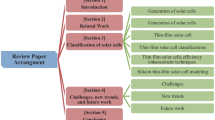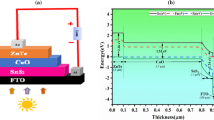Abstract
In this paper, we considered a silicon solar cell with some ribbon nanoparticles including silver (Ag), aluminum (Al), gold (Au), and platinum (Pt) ribbon nanoparticles. The dimensions of nanoparticles affect the absorption and efficiency of solar cells. Here, various dimensions were examined, and the width, height, and period of the ribbon nanoparticle were taken into account. In this paper, we investigated the effect of height, width, period, and materials of ribbon nanoparticles by finite-difference time-domain method. The simulation results show that the maximum absorption was obtained equal to 12.90% by using the silver ribbon nanoparticles having width (x) of 25 nm, height (h) of 50 nm, and period (p) of 50 nm. In this case, the fill factor was obtained as 81.31%.











Similar content being viewed by others
Availability of data and materials
The authors have no data to share since all data are shown in the submitted manuscript.
References
Xuan Y, Duan H, Li Q (2014) Enhancement of solar energy absorption using plasmonic nanofluid based on TiO2/Ag composite NPs. RSC Adv 4:16206–16213
Pustovalov VK, Astafyeva LG (2018) Optical properties of nanoparticles and nanofluids for direct absorption of solar radiation. Nanotechnol Environ Eng 3:1–15
Zalevsky Z, Abdulhalim I (2010) Integrated nanophotonic devices. Elsevier, Amsterdam. ISBN 978-1-4377-7848-9
Vora A (2015) Increasing solar energy conversion efficiency in thin film hydrogenated amorphous silicon solar cells with patterned plasmonic silver nano-disk array. Ph.D. thesis, campus access dissertation, Michigan Technological University
Akimov YA, Koh WS (2011) Design of plasmonic nanoparticles for efficient subwavelength light trapping in thin-film solar cells. Plasmonics 6(1):155–161
Maier SA (2007) Plasmonic: fundamental and aplications. Springer, New York. ISBN 0-387-33150-6
Ghahremanirad E, Olyaee S, Nejand BA, Ahmadi V, Abedi K (2018) Hexagonal array of mesoscopic HTM-based perovskite solar cell with embedded plasmonic nanoparticles. Phys Status Solidi (b) 255(3):1700291
Ghahremanirad E, Bou A, Olyaee S, Bisquert J (2017) Inductive loop in the impedance response of perovskite solar cells explained by surface polarization model. J Phys Chem Lett 8(7):1402–1406
Hedayati M, Olyaee S, Ghorashi SMB (2020) Improving the efficiency of double junction CIGS solar cell and investigating the effect of adsorbent layer thickness and gallium concentration on the efficiency. J Electron Mater 49(2):1454–1461
Adibzadeh F, Olyaee S (2020) Optical absorption enhancement in vertical InP nanowire random structures for photovoltaic applications. Opt Quantum Electron 52(1):1–14
Ghahremanirad E, Olyaee S, Abdollahi Nejand A, Nazari P, Ahmadi V, Abedi K (2018) Improving the performance of perovskite solar cells using kesterite mesostructure and plasmonic network. Solar Energy 169:498–504
Bozhevolnyi SI (2019) Plasmonic nanoguides and circuits. Pan Stanford Publishing Pte. Ltd., Singapore. ISBN 978-981-4241-32-8
Wen L, Sun F, Chen Q (2014) Cascading metallic gratings for broadband absorption enhancement in ultrathin plasmonic solar cells. Appl Phys Lett 104(15):151106
Reineck P, Lee GP, Brick D, Karg M, Mulvaney P, Bach U (2012) A solid-state plasmonic solar cell via metal nanoparticle self-assembly. Adv Mater 24(35):4750–4755
Mendes MJ et al (2015) Broadband light trapping in thin film solar cells with self-organized plasmonic nano-colloids. Nanotechnology 26(13):135202
Prabhathan P, Murukeshan VM (2016) Surface plasmon polariton-coupled waveguide back reflector in thin-film silicon solar cell. Plasmonics 11(1):253–260
Zhang D et al (2015) Aluminum nanoparticles enhanced light absorption in silicon solar cell by surface plasmon resonance. Opt Quantum Electron 47(6):1421–1427
Le Lay G et al (2009) Physics and chemistry of silicene nano-ribbons. Appl Surf Sci 256(2):524–529
Warner MG, Hutchison JE (2003) Linear assemblies of nanoparticles electrostatically organized on DNA scaffolds. Nat Mater 2(4):272
Lee DY et al (2013) Macroscopic nanoparticle ribbons and fabrics. Adv Mater 25(9):1248–1253
Orellana G, Moreno-Bondi MC (eds) (2006) Frontiers in chemical sensors: novel principles and techniques, vol 3. Springer, New York
Afkham H, Olyaee S, Sharif-Kazemi E (2019) Analysis and simulation of influence of the silver ribbon nanoparticle’s dimensions and refractive index on the efficiency of plasmonic amorphous silicon solar cell. J Appl Electromagn 7(1):9–16 (in Persian)
Acknowledgements
This research has been done in Nano-photonics and Optoelectronics Research Laboratory and the authors would like to thank SRTTU, Tehran, Iran for providing necessary analytical facilities.
Funding
No fund was received as support for this research work.
Author information
Authors and Affiliations
Contributions
All authors have contributed to the writing of the manuscript. All authors read and approved the final manuscript.
Corresponding author
Ethics declarations
Conflict of interest
The authors declare that there are no competing interests.
Informed consent
For this type of study formal consent is not required.
Research involving human participants and/or animals
This paper does not contain any studies with human participants or animals performed by any of the authors.
Additional information
Publisher's Note
Springer Nature remains neutral with regard to jurisdictional claims in published maps and institutional affiliations.
Rights and permissions
About this article
Cite this article
Sharif-Kazemi, E., Olyaee, S., Seifouri, M. et al. Investigation and simulation of the effect of silver, aluminum, gold, and platinum nano-ribbons on the efficiency of amorphous silicon solar cell. Nanotechnol. Environ. Eng. 5, 4 (2020). https://doi.org/10.1007/s41204-020-0067-1
Received:
Accepted:
Published:
DOI: https://doi.org/10.1007/s41204-020-0067-1




